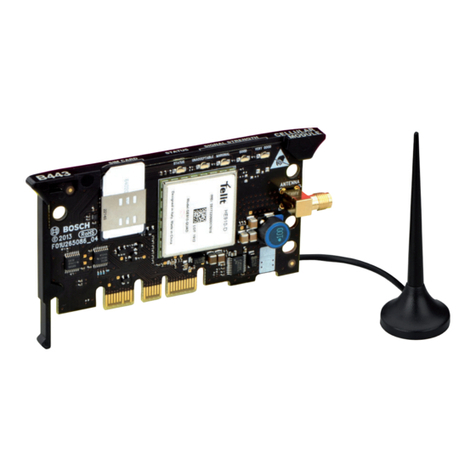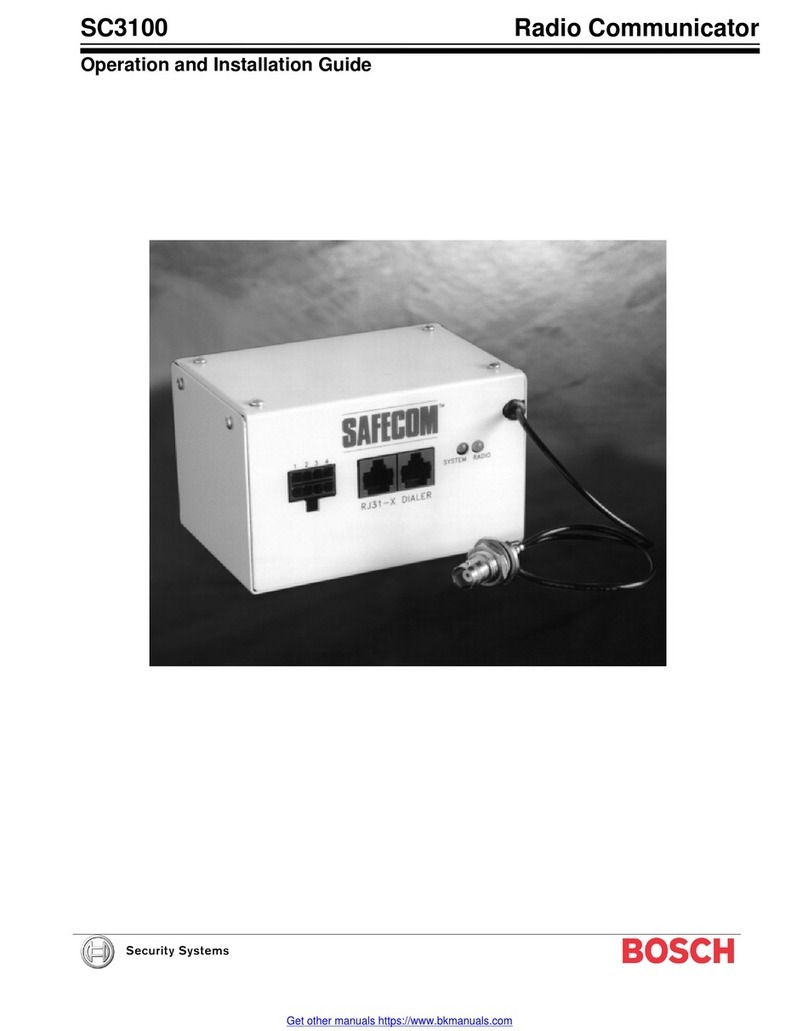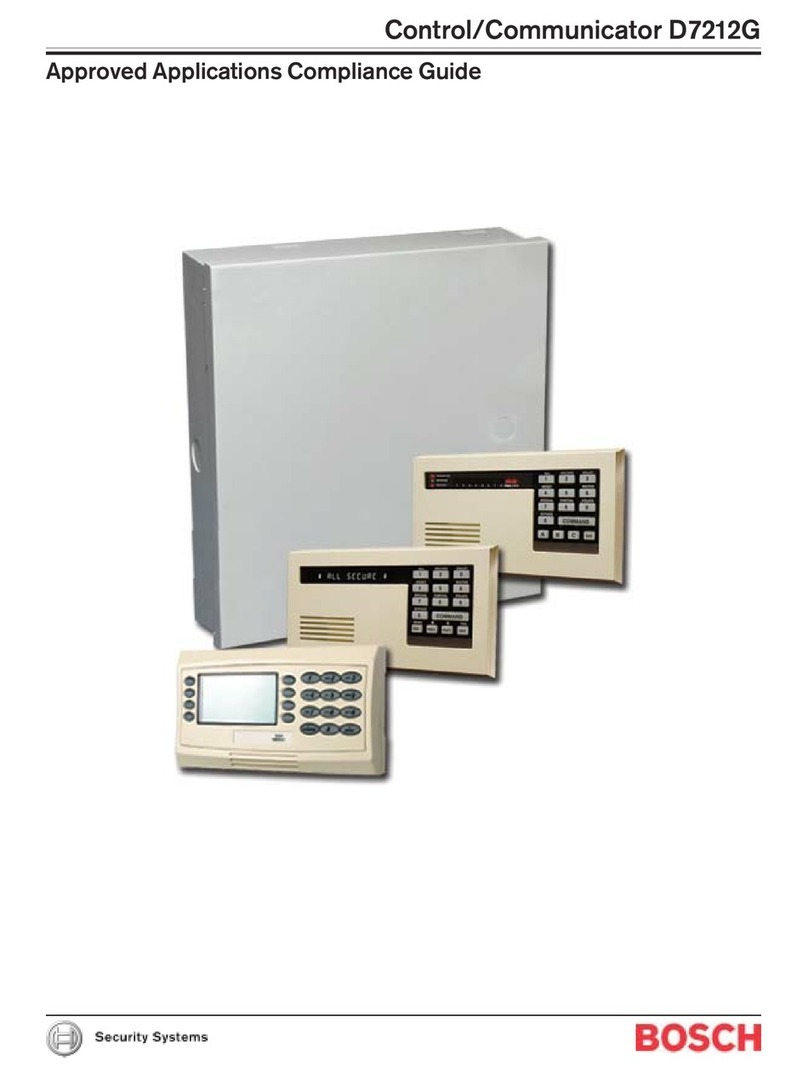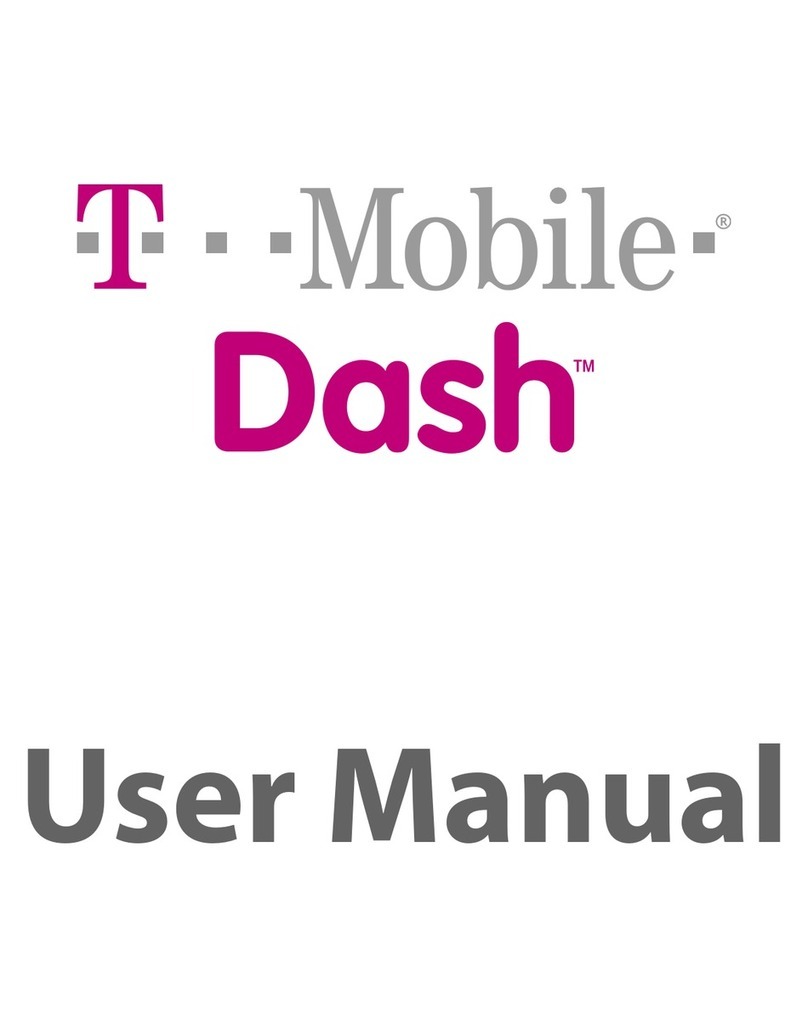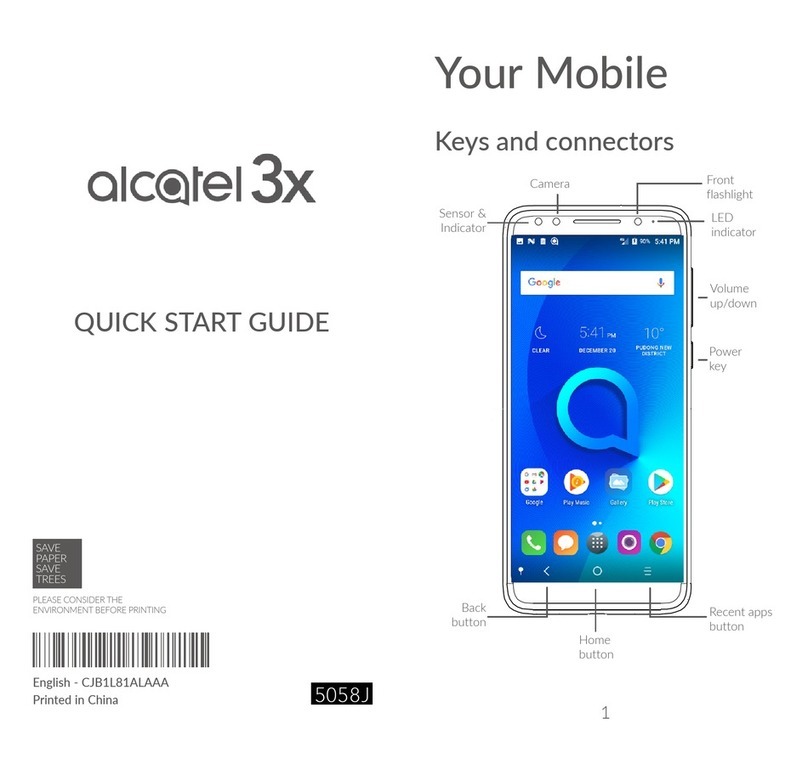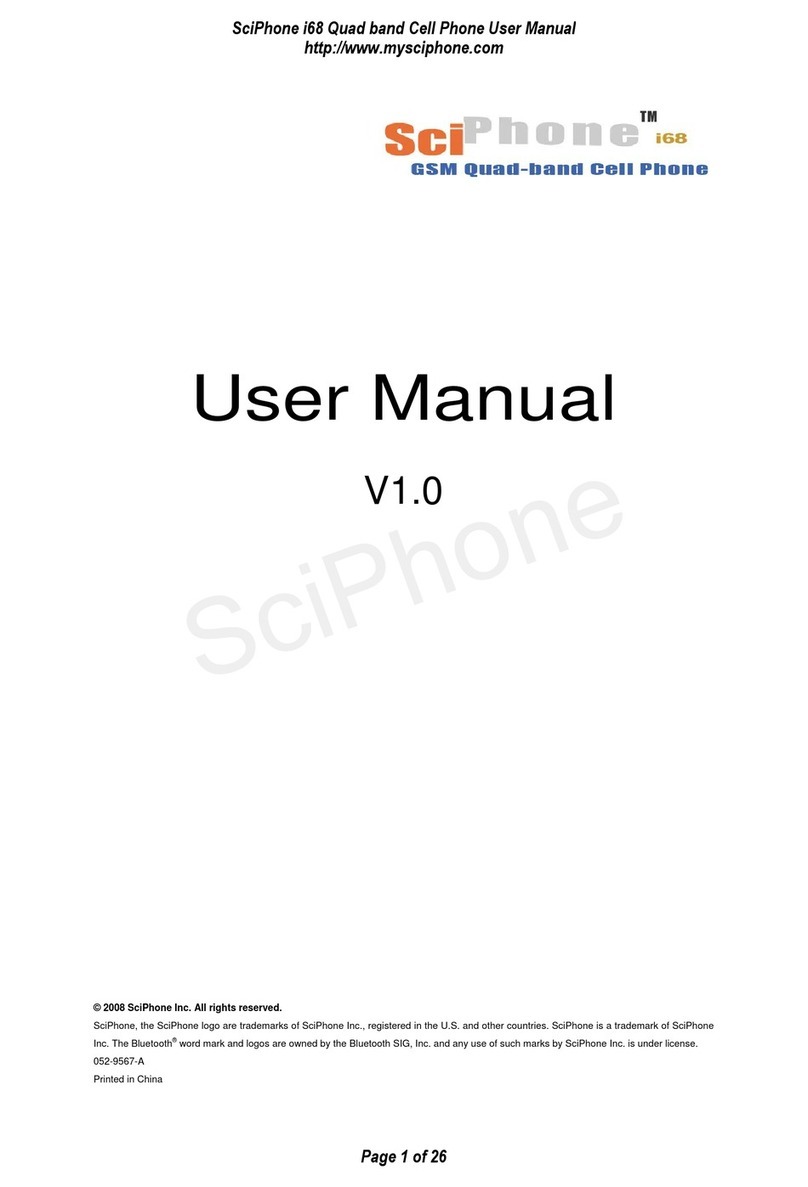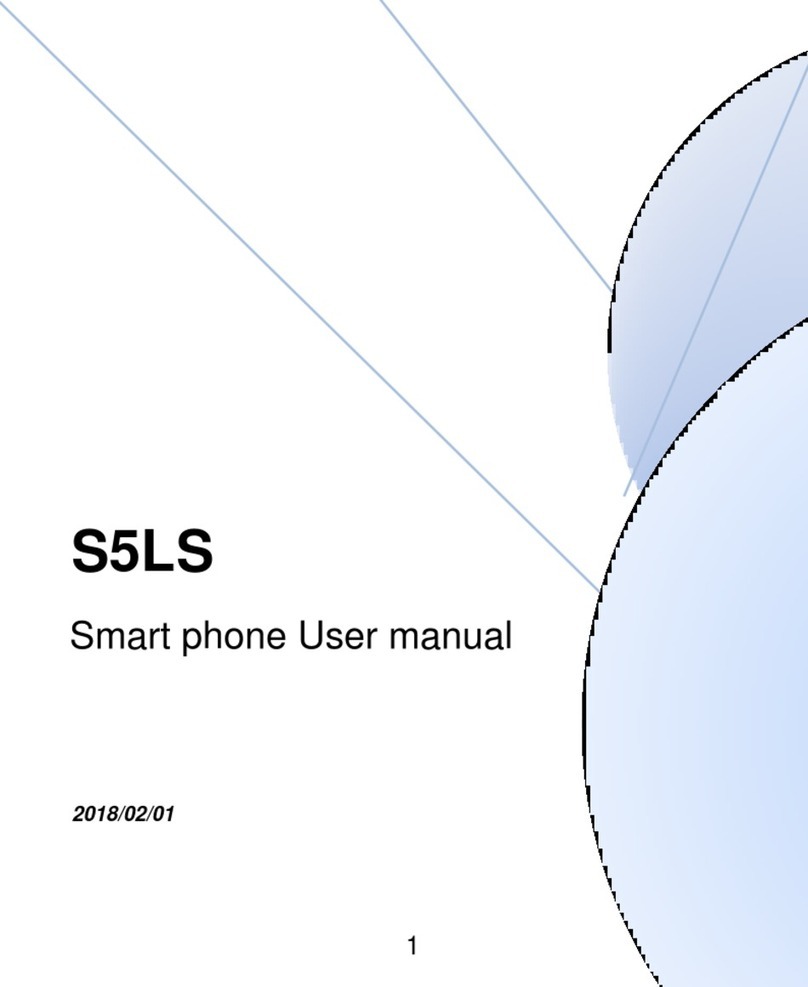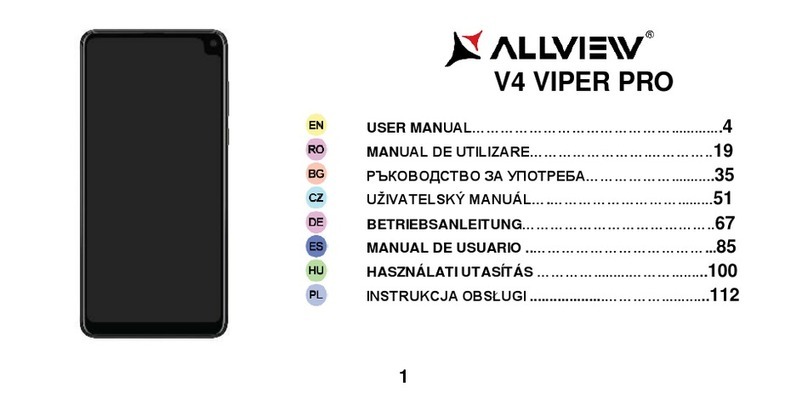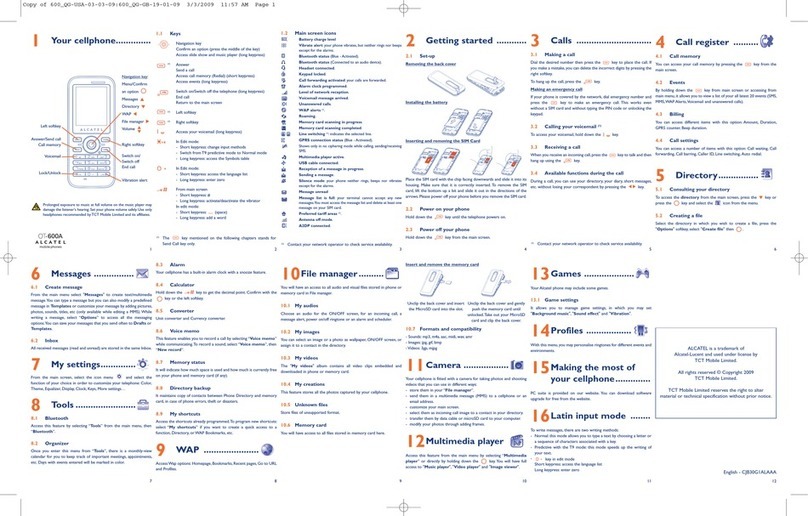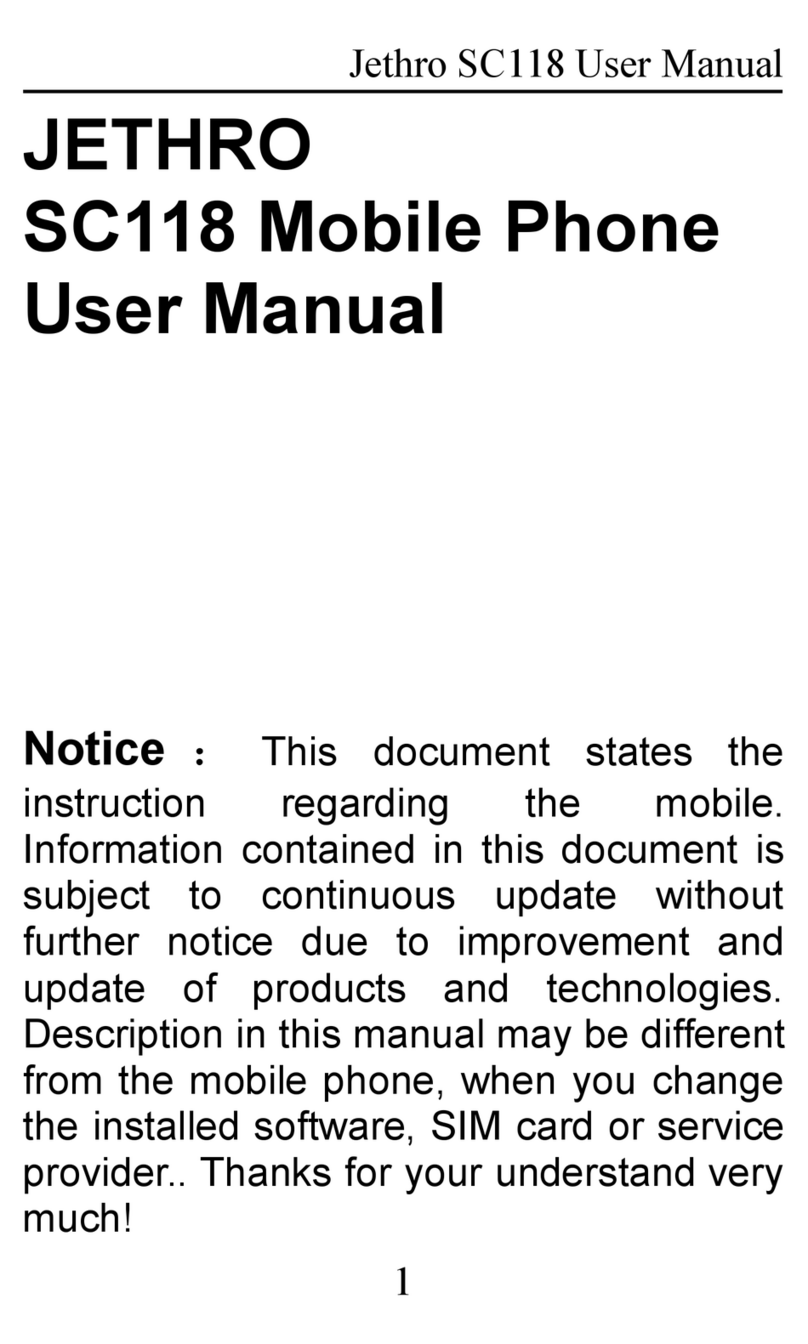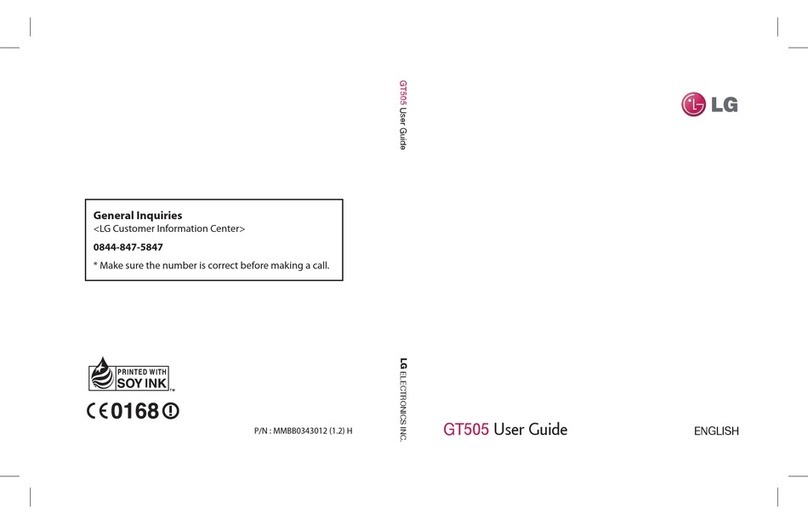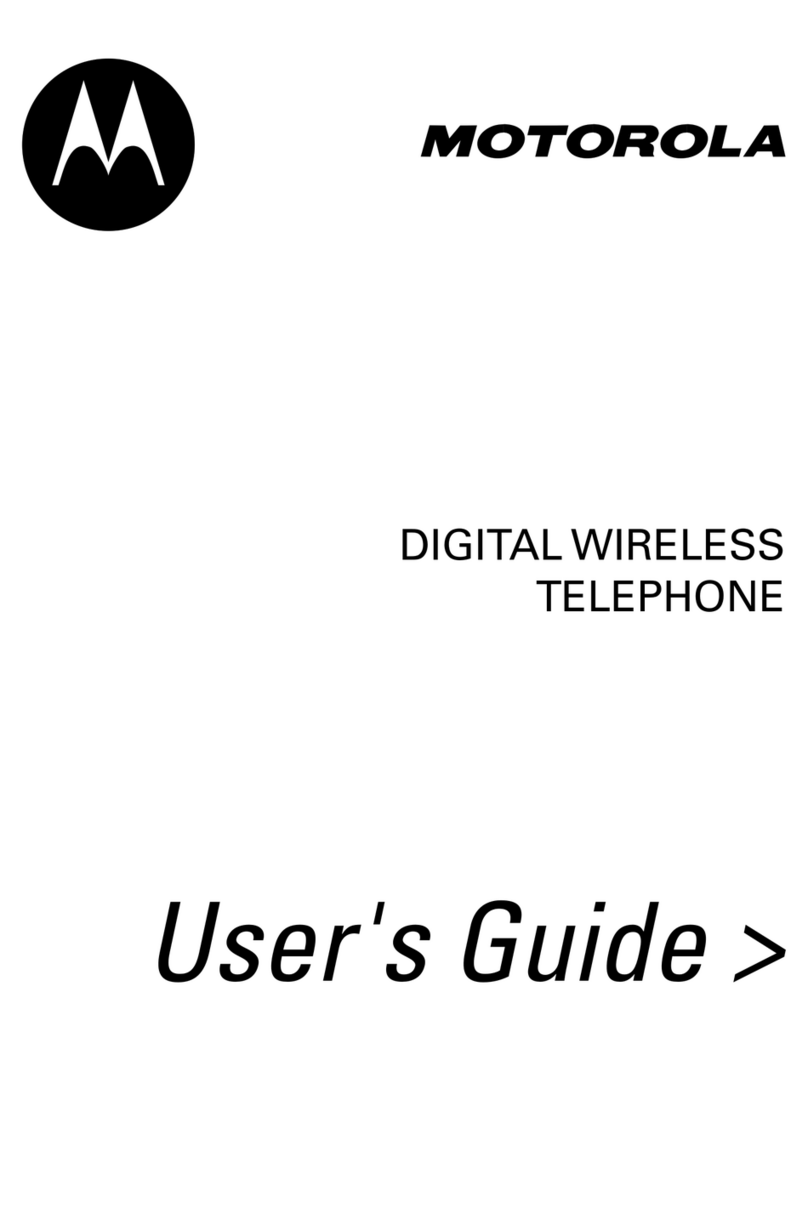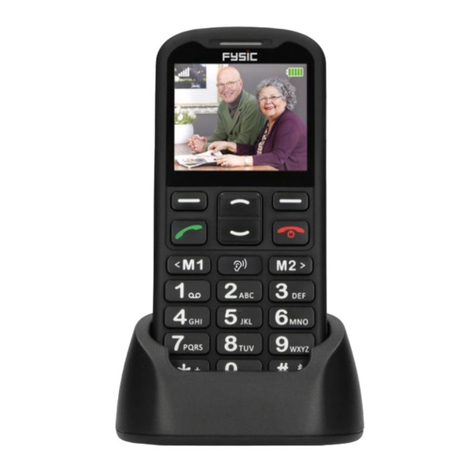Bosch D6412 User manual

D6412/D4412 Control/Communicator
Installation Guide

Page 245349D © 2002 Radionics
D6412/D4412 Installation Guide
D6412/D4412
Contents
Contents
1.0 Introduction ......................................................................................................................................................................... 7
1.1 Manual Organization ............................................................................................................................................................ 7
1.2 Other Literature Referenced ................................................................................................................................................ 8
1.3 Documentation Conventions................................................................................................................................................ 8
1.3.1 Type Styles Used in this Manual.......................................................................................................................................... 8
1.3.2 Tips, Important Notes, Cautions and Warnings.................................................................................................................. 9
1.4 FCC Notice............................................................................................................................................................................ 9
1.4.1 Part 15 ................................................................................................................................................................................... 9
1.4.2 Part 68 ................................................................................................................................................................................... 9
2.0 Overview ............................................................................................................................................................................ 10
2.1 Specifications.................................................................................................................................................................... 10
2.1.1 Voltage Input ....................................................................................................................................................................... 10
2.1.2 Current Requirements ........................................................................................................................................................ 10
2.1.3 Power Outputs .................................................................................................................................................................... 10
2.1.4 Battery Discharge/Recharge Schedule ............................................................................................................................. 11
2.1.5 Minimum Operating Voltage............................................................................................................................................... 11
2.1.6 SDI Bus (Data).................................................................................................................................................................... 11
2.1.7 Telephone Connections...................................................................................................................................................... 11
2.1.8 Environmental..................................................................................................................................................................... 11
2.1.9 Arming Stations .................................................................................................................................................................. 11
2.1.10 Compatible Enclosures ...................................................................................................................................................... 11
2.1.11 Compatible Accessories .................................................................................................................................................... 11
2.1.12 Control/Communicator Configurations.............................................................................................................................. 12
2.2 SIA Control Panel Standard ............................................................................................................................................... 12
2.3 Standard Features.............................................................................................................................................................. 12
2.3.1 Points................................................................................................................................................................................... 12
2.3.2 Areas and Accounts ........................................................................................................................................................... 12
2.3.3 Communicator .................................................................................................................................................................... 13
2.3.4 Command Centers ............................................................................................................................................................. 13
2.3.5 Keyswitch ............................................................................................................................................................................ 13
2.3.6 Alarm Event Memory .......................................................................................................................................................... 13
2.3.7 Event Log ............................................................................................................................................................................ 13
2.3.8 EMI/Lightning Transient Protection ................................................................................................................................... 14
2.3.9 Programming ...................................................................................................................................................................... 14
2.3.10 Other Features.................................................................................................................................................................... 14
2.3.11 Control/Communicator Assembly ...................................................................................................................................... 14
2.3.12 Listings and Approvals ....................................................................................................................................................... 15
3.0 Installation ......................................................................................................................................................................... 16
3.1 Before You Begin ................................................................................................................................................................ 16
3.2 Enclosure Options .............................................................................................................................................................. 16
3.3 Beginning the Installation................................................................................................................................................... 16
3.3.1 Mounting the Enclosure ..................................................................................................................................................... 16
3.4 Premises Wiring ................................................................................................................................................................. 16
3.5 Installing the Assembly ...................................................................................................................................................... 17
3.5.1 Connecting Earth Ground .................................................................................................................................................. 17
3.5.2 Closing the Installer Switch................................................................................................................................................ 18
3.6 Finishing the Installation .................................................................................................................................................... 18
3.6.1 Earth Ground and Installer Switch..................................................................................................................................... 18
3.6.2 Charge the Battery as You Finish ...................................................................................................................................... 18
3.6.3 Install and Wire Detection Devices ................................................................................................................................... 18
3.6.4 Install Modules .................................................................................................................................................................... 19
3.6.5 Make the Telephone Connections ..................................................................................................................................... 19
3.6.6 Connect the On-Board Points and Command Centers.................................................................................................... 19
3.6.7 Power Up............................................................................................................................................................................. 19
3.7 Programming the Panel ..................................................................................................................................................... 19
3.8 Check for Fire Alarm Verification ....................................................................................................................................... 20
3.9 Testing the System ............................................................................................................................................................. 20

Page 3© 2002 Radionics D6412/D4412 Installation Guide 45349D
D6412/D4412
Contents
4.0 Power Supply .................................................................................................................................................................... 20
4.1 Primary Power .................................................................................................................................................................... 20
4.1.1 Primary (AC) Power Circuit ................................................................................................................................................ 20
4.1.2 Installing the Transformer .................................................................................................................................................. 20
4.2 Secondary Power ............................................................................................................................................................... 20
4.2.1 Secondary (DC) Power ...................................................................................................................................................... 20
4.2.2 Installing the Battery........................................................................................................................................................... 21
4.2.3 Replacement....................................................................................................................................................................... 21
4.2.4 Battery Supervision ............................................................................................................................................................ 21
4.2.5 Battery Charging Circuit ..................................................................................................................................................... 21
4.2.6 Battery Discharge/Recharge Schedule ............................................................................................................................. 21
4.2.7 System Status LED ............................................................................................................................................................ 22
4.3 External Power Supply ....................................................................................................................................................... 22
5.0 Power Outputs .................................................................................................................................................................. 22
5.1 Circuit Protection ................................................................................................................................................................ 22
5.2 Available Power .................................................................................................................................................................. 22
5.2.1 Auxiliary Power ................................................................................................................................................................... 22
5.2.2 Installer’s Keypad Connector............................................................................................................................................. 22
5.2.3 Alarm Power........................................................................................................................................................................ 23
5.3 Continuous Power Output .................................................................................................................................................. 23
5.3.1 Continuous Current Draw................................................................................................................................................... 23
5.4 Alarm Power........................................................................................................................................................................ 23
5.4.1 Available Power .................................................................................................................................................................. 23
5.5 Output Programming .......................................................................................................................................................... 23
6.0 Telephone Connections................................................................................................................................................... 24
6.1 Registration......................................................................................................................................................................... 24
6.2 Notification .......................................................................................................................................................................... 24
6.3 Location............................................................................................................................................................................... 25
6.4 Phone Cord Connection..................................................................................................................................................... 25
6.5 System Status LED (Red) .................................................................................................................................................. 25
6.6 Dialing Format .................................................................................................................................................................... 25
6.7 Phone Line Fault ................................................................................................................................................................ 26
6.8 Called Party Disconnect..................................................................................................................................................... 26
6.9 Communication Failure ...................................................................................................................................................... 26
6.10 Ground Start........................................................................................................................................................................ 26
7.0 Onboard Sensor Loops ................................................................................................................................................... 28
7.1 Description .......................................................................................................................................................................... 28
7.2 Two-wire Smoke Detector Configuration........................................................................................................................... 28
7.3 Four-wire Smoke Detector Configuration.......................................................................................................................... 28
7.4 Sensor Loop 1 Configuration ............................................................................................................................................. 29
7.5 Single Point Configuration (Points 2-8)............................................................................................................................. 29
7.6 Doubled Point Configuration.............................................................................................................................................. 30
7.7 Sensor Loop Response Time ............................................................................................................................................ 31
8.0 Off-board Sensor Loops .................................................................................................................................................. 32
8.1 SDI Point Expanders .......................................................................................................................................................... 32
8.2 DX2010 Point Expander Module ....................................................................................................................................... 34
8.2.1 DX2010 Overview ............................................................................................................................................................... 34
8.2.2 DX2010 Installation ............................................................................................................................................................ 34
8.2.3 DX2010 to Panel SDI Bus Connections............................................................................................................................ 36
8.2.4 DX2010 Auxiliary Output Connections.............................................................................................................................. 37
8.2.5 DX2010 Tamper Input Connections .................................................................................................................................. 38
8.2.6 DX2010 Sensor Loop (Point) Connections....................................................................................................................... 38
8.2.6.1 DX2010 Standard Sensor Loop Wiring............................................................................................................................. 38
8.2.6.2 DX2010 Doubled Sensor Loop (Point) Wiring.................................................................................................................. 39
8.2.7 DX2010 Address Programming ......................................................................................................................................... 39
8.2.8 DX2010 Status LED ........................................................................................................................................................... 40
9.0 On-Board Outputs ............................................................................................................................................................ 41

Page 445349D © 2002 Radionics
D6412/D4412 Installation Guide
D6412/D4412
Contents
10.0 Off-Board Outputs ............................................................................................................................................................ 42
10.1 Overview ............................................................................................................................................................................. 42
10.2 DX3010 Octo-Output Module............................................................................................................................................. 42
10.2.1 Overview ............................................................................................................................................................................. 42
10.2.2 Configuring the DX3010 Octo-Output Module .................................................................................................................. 42
10.2.3 Relay Outputs ..................................................................................................................................................................... 42
10.2.4 Installation ........................................................................................................................................................................... 43
10.2.5 DX3010 to D6412/D4412 SDI Bus Wiring Connections .................................................................................................. 44
10.2.6 Address Programming ....................................................................................................................................................... 45
11.0 Arming Devices ................................................................................................................................................................. 46
11.1 Description .......................................................................................................................................................................... 46
11.2 Command Centers ............................................................................................................................................................. 46
11.2.1 Assigning the Command Center an Address ................................................................................................................... 46
11.2.2 Command Center Installation ............................................................................................................................................ 47
11.3 D268/D269, D279 Independent Zone Control.................................................................................................................. 48
11.4 Keyswitch ............................................................................................................................................................................ 49
11.4.1 Keyswitch Description ........................................................................................................................................................ 49
11.4.2 Keyswitch Programming .................................................................................................................................................... 49
11.4.3 Keyswitch Installation ......................................................................................................................................................... 49
11.4.4 Keyswitch Operation........................................................................................................................................................... 49
12.0 SDI Devices........................................................................................................................................................................ 50
12.1 Description .......................................................................................................................................................................... 50
12.2 Installation ........................................................................................................................................................................... 50
12.3 DX4010 RS-232 Serial Interface Module .......................................................................................................................... 51
12.3.1 DX4010 Installation ............................................................................................................................................................ 52
12.3.2 DX4010 to D6412/D4412 SDI Bus Wiring Connections .................................................................................................. 52
12.3.3 RAM IV Direct Connection ................................................................................................................................................. 52
12.3.4 Configuration Jumpers ....................................................................................................................................................... 53
12.3.5 Supervision ......................................................................................................................................................................... 54
12.3.6 DX4010 Module’s DB9 Connector..................................................................................................................................... 54
13.0 Installer’s Keypad and Installer Mode ........................................................................................................................... 55
13.1 Installer’s Keypad Connector............................................................................................................................................. 55
13.2 Entering the Installer Mode ................................................................................................................................................ 55
13.2.1 Installer’s Passcode ........................................................................................................................................................... 55
13.2.2 Service Start/Service End Reports .................................................................................................................................... 56
13.3 Installer’s Menu................................................................................................................................................................... 56
13.3.1 Press [1] for Bell Test ......................................................................................................................................................... 56
13.3.2 Press [2] for Strobe Test..................................................................................................................................................... 56
13.3.3 Press [3] for Battery Test .................................................................................................................................................... 56
13.3.4 Press [4] for Test Report .................................................................................................................................................... 56
13.3.5 Press [5] for Point Status ................................................................................................................................................... 56
13.3.6 Press [6] for Output Test .................................................................................................................................................... 57
13.3.7 Press [7] for RF Menu ........................................................................................................................................................ 57
13.3.7.1 Adding RF ID Codes .......................................................................................................................................................... 57
13.3.7.2 Testing RF Devices ............................................................................................................................................................. 58
13.3.7.3 Viewing/Removing RF ID Codes ....................................................................................................................................... 59
13.3.8 Press [8] for Keypad Program ........................................................................................................................................... 59
13.3.9 Press [9] Program Key ....................................................................................................................................................... 59
13.3.10 Exiting the Installer’s Menu ................................................................................................................................................ 60
13.3.11 Press [0] Call for Service Details ....................................................................................................................................... 61
14.0 Installation Label .............................................................................................................................................................. 62
15.0 Terminal Quick Reference ............................................................................................................................................... 64
16.0 Troubleshooting................................................................................................................................................................ 65
16.1 Introduction ......................................................................................................................................................................... 65
16.1.1 Arming Issues ..................................................................................................................................................................... 65
16.1.2 Point Issues ........................................................................................................................................................................ 65
16.1.3 Command Center Issues ................................................................................................................................................... 66
16.1.4 Programming Issues .......................................................................................................................................................... 66
16.1.5 Miscellaneous Issues ......................................................................................................................................................... 66

Page 5© 2002 Radionics D6412/D4412 Installation Guide 45349D
D6412/D4412
Tables
Appendix A: Approved Applications Compliance Guide ......................................................................................................... 67
Listings and Approvals ...................................................................................................................................................................... 67
System Chart ..................................................................................................................................................................................... 68
System Wiring Diagrams, Issue A.................................................................................................................................................... 69
Current Rating Chart for Standby Battery Calculations .................................................................................................................. 70
Standby Battery Requirements......................................................................................................................................................... 71
Standby Battery Calculation for NFPA 72 Fire Alarm Applications ................................................................................................ 71
Appendix B: SDI Address Chart ................................................................................................................................................... 71
Tables
Table 1: D6412/D4412 Installation Guide Manual Organization....................................................................................................... 7
Table 2: Other Literature Referenced ................................................................................................................................................. 8
Table 3: Compatible Command Centers .......................................................................................................................................... 13
Table 4: Point Scan Time/Pulse Count Time Selections ................................................................................................................. 31
Table 5: Off-Board Sensor Loops - Location/Address Assignment ................................................................................................ 33
Table 6: DX2010 Wire Lengths........................................................................................................................................................ 36
Table 7: DX2010 Address 106 .......................................................................................................................................................... 39
Table 8: DX2010 Address 107 (for D6412 only) .............................................................................................................................. 39
Table 9: DX2010 Address Settings................................................................................................................................................... 39
Table 10: DX2010 Address Jumper Settings ................................................................................................................................... 40
Table 11: DX3010 Wire Lengths ....................................................................................................................................................... 44
Table 12: DX3010 Address Settings................................................................................................................................................. 45
Table 13: DX3010 Address Jumper Settings ................................................................................................................................... 45
Table 14: Command Center Address Assignments DIP Switch Settings ...................................................................................... 46
Table 15: Command Center Wire Lengths ...................................................................................................................................... 47
Table 16: DX4010 Address Settings................................................................................................................................................. 54

Page 645349D © 2002 Radionics
D6412/D4412 Installation Guide
D6412/D4412
Figures
Figures
Figure 1: System Configuration ........................................................................................................................................................ 10
Figure 2: Enclosure Mounting........................................................................................................................................................... 17
Figure 3: Installer Switch................................................................................................................................................................... 18
Figure 4: System Status LED ........................................................................................................................................................... 22
Figure 5: On-Board Outputs.............................................................................................................................................................. 24
Figure 6: RJ31X/RJ38X Wiring......................................................................................................................................................... 25
Figure 7: System Status LED ........................................................................................................................................................... 25
Figure 8: Ground Start....................................................................................................................................................................... 27
Figure 9: Typical Two-Wire Smoke Detector Wiring ....................................................................................................................... 28
Figure 10: Typical Four-Wire Smoke Detector Wiring .................................................................................................................... 29
Figure 11: Sensor Loop 1 Wiring...................................................................................................................................................... 29
Figure 12: Single Point Sensor Loop Wiring ................................................................................................................................... 29
Figure 13: On-board Doubled Point Sensor Loop Wiring ............................................................................................................... 30
Figure 14: Installing the DX2010 in D203 Enclosure ...................................................................................................................... 34
Figure 15: Installing the DX2010 in the Panel’s Enclosure............................................................................................................. 35
Figure 16: Optional Enclosure Mounting Locations for the DX2010 .............................................................................................. 35
Figure 17: Wiring the DX2010 to the D6412/D4412 ....................................................................................................................... 36
Figure 18: Wiring the DX2010 for External Power Supply.............................................................................................................. 37
Figure 19: Auxiliary Output Connections ......................................................................................................................................... 37
Figure 20: DX2010 Tamper Input Wiring ......................................................................................................................................... 38
Figure 21: DX2010 Sensor Loop Wiring, Single Loop Configuration ............................................................................................ 38
Figure 22: DX2010 Sensor Loop Wiring, Doubled Loop Configuration ......................................................................................... 39
Figure 23: DX2010 DIP Switch Configuration.................................................................................................................................. 40
Figure 24: DX2010 Status LED ........................................................................................................................................................ 40
Figure 25: PO 1 Wiring...................................................................................................................................................................... 41
Figure 26: PO 2 - PO 4 Wiring.......................................................................................................................................................... 41
Figure 27: DX3010 - Control Panel Enclosure Side Mounting ....................................................................................................... 43
Figure 28: Installing the DX3010 in a Remote Enclosure ............................................................................................................... 43
Figure 29: Wiring the DX3010 to the D6412/D4412 ....................................................................................................................... 44
Figure 30: Wiring for External Power Supply................................................................................................................................... 45
Figure 31: DX3010 Address DIP Switches ...................................................................................................................................... 45
Figure 32: Command Center DIP Switch Orientation ..................................................................................................................... 46
Figure 33: Wiring Command Centers to the D6412/D4412............................................................................................................ 47
Figure 34: External Power for Command Centers .......................................................................................................................... 48
Figure 35: Keyswitches ..................................................................................................................................................................... 49
Figure 36: SDI Device Wiring ........................................................................................................................................................... 50
Figure 37: External Power for SDI Devices ..................................................................................................................................... 51
Figure 38: DX4010 RS-232 Serial Interface Module ....................................................................................................................... 51
Figure 39: DX4010 Power Connections........................................................................................................................................... 52
Figure 40: Creating a RAM IV Direct Connection............................................................................................................................ 53
Figure 41: DX4010 P2/P3 Jumper Pin Settings .............................................................................................................................. 53
Figure 42: DX4010 DIP Switch Orientation...................................................................................................................................... 54
Figure 43: DX4010 DB9 Connector Layout ..................................................................................................................................... 54
Figure 44: Installer’s Keypad ............................................................................................................................................................ 55
Figure 45: Installer Switch................................................................................................................................................................. 56
Figure 46: Adding RF ID Codes Menu Display................................................................................................................................ 57
Figure 47: RF ID Code Display......................................................................................................................................................... 57
Figure 48: Test RF Devices Display ................................................................................................................................................. 58
Figure 49: RF Device Test Status Display ....................................................................................................................................... 58
Figure 50: RF ID Code Display......................................................................................................................................................... 59
Figure 51: PK32 to D6412/D4412 Connections .............................................................................................................................. 60

Page 7© 2002 Radionics D6412/D4412 Installation Guide 45349D
D6412/D4412
1.0 Introduction
This manual addresses the installation of the D6412 and D4412 Control/Communicators only, and should not
be used for any other panel.
1.1 Manual Organization
This manual is divided into 16 sections with seven appendices. Table 1 contains a summary of each section.
Section Description
1.0 Introduction - this section.
2.0 Overview - provides an overview of the D6412/D4412 Control/Communicators,
including operational specifications, standard and new features.
3.0 Installation - provides basic installation instructions, everything needed to get the
panel powered up and ready for programming.
4.0 Power Supply - provides information on the primary and secondary power
soruces and instructions on connecting them.
5.0 Power Outputs - provides information on the available powered outputs, including
the alarm output and the built-in siren driver.
6.0 Telephone Connections - provides information on connecting the phone line.
7.0 On-Board Sensor Loops - provides information on the eight on-board sensor
loops available on the D6412/D4412.
8.0 Off-Board Sensor Loops - provides information on available off-board sensor
loops, including detailed instructions for connecting the DX2010 Point Expansion
Module.
9.0 On-Board Outputs - provides information on the four on-board programmable
outputs.
10.0 Off-Board Outputs - provides information on available off-board programmable
outputs, including detailed instructions for connecting the DX3010 OctoOutput
Module.
11.0 Arming Devices - provides information on command centers, keyswitches and
independent zone controls.
12.0 SDI Devices - provides descriptions and installation instructions for various
optional modules that connect to the D6412/D4412's data terminals (SDI bus).
13.0 Installer's Keypad and Installer Mode - provides information for using an
Installer's Keypad and the Installer's Mode.
14.0 Installation Label - a copy of the installation label found inside of the
D6412/D4412's enclosure.
15.0 Terminal Quick Reference - a chart providing a short description of each
D6412/D4412 terminal.
16.0 Troubleshooting - provides potential solutions to a variety of commonly
encountered problems.
Appendices A: Approved Applications and Compliance Guide
B: SDI Address Chart
Table 1: D6412/D4412 Installation Guide Manual Organization
Introduction

Page 845349D © 2002 Radionics
D6412/D4412 Installation Guide
D6412/D4412
1.2 Other Literature Referenced
Throughout this manual, references will be made to other documentation. Review the documents in the table
below for a complete description of the panel. Part numbers are included for ordering purposes.
Name of Document Part Number
D6412/D4412 Program Entry Guide 45351
D6412 Program Record Sheet 45350
D4412 Program Record Sheet 50485
D6412/D4412 Smoke Detector Compatibility List 46928
User's Guide for LED Command Centers 46840
User's Guide for Text Command Centers 46841
D6412 Firmware Release Notes 46929
D4412 Firmware Release Notes 50482
DX2010 Installation Guide 49533
DX3010 Installation Guide 49529
DX4010 Installation Guide 49539
Table 2: Other Literature Referenced
1.3 Documentation Conventions
These conventions are intended to call out important features, items, notes, cautions, and warnings that the
reader should be aware of in reading this document.
1.3.1 Type Styles Used in this Manual
To help identify important items in the text, the following type styles are used:
Bold text usually indicates selections that you may use while programming your panel. It may
also indicates an important fact that should be noted.
Bold Italicized used to denote notes, cautions and/or warnings.
Italicized text refers the user to another part of this manual or another manual entirely.
Courier Text indicates what may appear on the command center/keypad or in a report received at
the central station receiver.
[Text in brackets] indicates to the user that a specific key should be pressed.
Example: …press [Cmd] to exit this feature…
Introduction

Page 9© 2002 Radionics D6412/D4412 Installation Guide 45349D
D6412/D4412
1.3.2 Tips, Important Notes, Cautions and Warnings
Throughout this document, helpful tips, important notes, cautions and warnings will be presented for the reader
to keep in mind. These appear different from the rest of the text as follows;
IMPORTANT
Important Notes - should be heeded for successful operation and programming. Also tips and shortcuts
may be included here.
CAUTION
Caution - These caution the operator that physical damage to the panel and/or optional equipment may
occur.
WARNING
Warning - These warn of the possibility of physical damage to the operator and/or equipment.
1.4 FCC Notice
1.4.1 Part 15
This equipment has been tested and found to comply with the limits for a Class B digital device, pursuant to part
15 of the FCC rules. These limits are designed to provide reasonable protection against harmful interference
when the equipment is operated in a commercial environment.
This equipment generates, uses, and can radiate radio frequency energy and, if not installed and used in
accordance with this instruction manual, may cause harmful interference to radio communications.
Operation of this equipment in a residential area is likely to cause harmful interference in which case the user
will be required to correct the interference at his own expense.
1.4.2 Part 68
This equipment complies with Part 68 of FCC rules. A label contains, among other information, the FCC
registration number and ringer equivalence number (REN). If requested, this information must be provided to the
telephone company.
The Radionics D6412/D4412 Control/Communicator is registered for connection to the public telephone network
using an RJ38X or RJ31X jack.
The ringer equivalence number (REN) is used to determine the number of devices that may be connected to the
telephone line. Excessive RENs on the telephone line may result in the devices not ringing in response to an
incoming call. In most, but not all areas, the sum of the RENs should not exceed five (5). To be certain of the
number of devices that may be connected to the line, as determined by the RENs, contact the telephone
company to determine the maximum REN for the calling area.
If the D6412/D4412 Control/Communicator causes harm to the telephone network, the telephone company will
notify you in advance. If advance notice isn’t practical, the telephone company will notify the customer as soon
as possible. Also, you will be advised of your right to file a complaint with the FCC if you believe it is necessary.
The telephone company may make changes in its facilities, equipment, operations, or procedures that could
affect the operation of the equipment. If this happens, the telephone company will provide advance notice in
order for you to make the necessary modifications in order to maintain uninterrupted service.
If trouble is experienced with the D6412/D4412 Control/Communicator, please contact Radionics Customer
Service for repair and/or warranty information. If the trouble is causing harm to the telephone network, the
telephone company may request that you remove the equipment from the network until the problem is resolved.
User repairs must not be made, and doing so will void the user’s warranty.
This equipment cannot be used on public coin service provided by the telephone company. Connection to Party
Line service is subject to state tariffs. (Contact your state public utilities commission for information.)
FCC Registration Number: ESVMUL-46531-AL-E
Ringer Equivalence: 0.1B
Service Center in USA: National Repair Center
130 Perinton Parkway
Fairport, NY 14450-9199 USA
(800) 289-0096 ext. 4220
Introduction

Page 1045349D © 2002 Radionics
D6412/D4412 Installation Guide
D6412/D4412
2.0 Overview
DX2010
PointExpansion Module
DX3010
Octo-OutputModule
UseCommand Centersand/orkeyswitchesto
armthe panelbyarea.Eacharea can haveits
ownaccountnumberorareascan be grouped
togetherwithacommon accountnumber.
Pointsofprotection areassigned toareas.
Control/
Communicator
8On-Board
SensorLoops
4On-Board
Outputs
D8132 modulesprovide
additionalpowerforcommand
centersand otherpowered
devices.
DX4010
SerialInterfaceModule
(forconnection ofserialprinter
orotherRS-232 device)
RF3224 Premises
RFReceiver
(up to4RFkeypads
and 32 keyfobs)
DX3020 Module
Providescontrolfor
X-10 modules.
Figure 1: System Configuration
2.1 Specifications
2.1.1 Voltage Input
Primary
18 VAC 22 VA class 2 plug-in transformer CX4010 (D1825)
Secondary
12 VDC, 7 Ah sealed lead acid rechargeable battery or 12 VDC, 18 Ah sealed lead acid rechargeable battery.
2.1.2 Current Requirements
Panel – 100 mA
See Appendix A, Approved Applications Compliance Guide, for the current requirements of other system
components.
2.1.3 Power Outputs
Continuous Power
Up to 600 mA maximum at 11.5 VDC to 12.4 VDC (continuous supply) total for all devices and outputs for non
UL applications.
IMPORTANT
Up to 400 mA at 11.5 VDC to 12.4 VDC for UL listed burglary applications, 120 mA for Fire and
Combined Burglary/Fire (continuous supply) total for all devices and outputs.
Alarm Power
400 mA for Fire and combined Fire/Burglary; 1500 mA for UL Burglary; 1850 mA for other (not investigated by
UL). Applies to all four outputs combined. See the Outputs section of the D6412/D4412 Program Entry Guide
(P/N: 45351).
Overview

Page 11© 2002 Radionics D6412/D4412 Installation Guide 45349D
D6412/D4412
2.1.4 Battery Discharge/Recharge Schedule
Discharge Cycle
AC Off: Command centers indicate trouble. AC Fail report sent as programmed.
13.8 VDC: Charging Float Level
12.1 VDC: Low Battery trouble at command centers. Low Battery report as programmed.
10.2 VDC: Panel shuts down as voltage falls below 10.2 VDC
Recharge Cycle
AC On: Panel restarts, battery charging begins, AC restoral report sent as programmed, AC trouble clears from
command centers.
13.0 VDC: Battery restoral reports sent, battery trouble clears from command centers.
13.8 VDC: Battery float charged.
2.1.5 Minimum Operating Voltage
10.2 VDC
2.1.6 SDI Bus (Data)
12 VDC nominal. 1,000 ft. (305 m) of 22 AWG (0.8 mm) cable.
2.1.7 Telephone Connections
RJ31X or RJ38X jack can be interfaced with panel.
2.1.8 Environmental
Temperature: +32° to +122°F (0° to +50°C)
Relative Humidity: 5-85% at 86°F (30°C) non-condensing
2.1.9 Arming Stations
D625 VF Text Command Center
D623 LCD Text Command Center
D621 LED Command Center
Keyswitch
2.1.10 Compatible Enclosures
D2203 Universal Enclosure (included with panel), D8103 Universal Enclosure*, D8109 Fire Enclosure*, D8108A
Attack Resistant Enclosure*
*When ordering a compatible enclosure, order the D6412M (includes the mounting skirt and the D6412LC) or
the D4412M (includes the mounting skirt and the D4412LC). In addition, please order the CX4010 transformer.
2.1.11 Compatible Accessories
D621 LED Command Center
D623 Text Command Center, LCD Display
D625 Text Command Center, Vacuum Fluorescent Display
DX2010 (D9528) Point Expansion Module
DX3010 (D9529) Octo-Output Module
DX3020 (X7410i) Module (not investigated by UL)
DX4010 (D9533) Serial Output Module (not investigated by UL)
DX8010 Telephone Command Module (not investigated by UL)
DS RF3224 Premises RF Receiver
DS RF3332/3334 Keyfob (not investigated by UL)
DS RF3341 Keypad (not investigated by UL)
Programming Key (PK32)
Overview

Page 1245349D © 2002 Radionics
D6412/D4412 Installation Guide
D6412/D4412
2.1.12 Control/Communicator Configurations
D6412 - Complete Control/Communicator assembly in the D2203 Universal Enclosure. A CX4010 Transformer
is supplied.
D6412LT - Complete Control/Communicator assembly in the D2203 Universal Enclosure. A CX4010
Transformer must be ordered separately.
D6412LC - Complete Control/Communicator assembly without an enclosure or transformer. A CX4010
Transformer must be ordered separately.
D6412M - Complete Control/Communicator assembly with a mounting skirt for the compatible enclosure. A
CX4010 Transformer must be ordered separately. See Section 2.1.10 for compatible enclosure alternatives.
D4412 - Complete Control/Communicator assembly in the D2203 Universal Enclosure. A CX4010 Transformer
is supplied.
D4412LT - Complete Control/Communicator assembly in the D2203 Universal Enclosure. A CX4010
Transformer must be ordered separately.
D4412LC - Complete Control/Communicator assembly without an enclosure or transformer. A CX4010
Transformer must be ordered separately.
D4412M - Complete Control/Communicator assembly with a mounting skirt for the compatible enclosure. A
CX4010 Transformer must be ordered separately. See Section 2.1.10 for compatible enclosure alternatives.
2.2 SIA Control Panel Standard
The D6412/D4412 utilizes features within the SIA Control Panel Standard, Features for False Alarm Reduction,
SIA CP-01-1994.02 (R2000.01). SIA features are noted in the D6412/D4412 Program Entry Guide (P/N: 45351).
The standard is available through the Security Industry Association (SIA), 635 Slaters Lane, Suite 110,
2.3 Standard Features
2.3.1 Points
Radionics’ D6412 Control/Communicator panel provides up to 40 separate points of protection (24 for the
D4412 panel). Point programming parameters determine the panel’s response to open and shorted conditions
on the point’s sensor loop. Points are programmed individually with several options to customize the protection
to your installation.
There are eight sensor loops available on the panel (for ‘on-board’ points). Off-board point locations can be
standard wired sensor loops (DX2010 Point Expander) or premises RF transmitters (premises RF receiver is
required).
The 40 points of protection for the D6412 (24 points for the D4412) can be located on any combination of wired
and RF locations.
2.3.2 Areas and Accounts
The system supports up to four separate areas for the D6412 and up to two separate areas for the D4412. You
can assign all points to a single area or spread them out over a maximum of two or four areas, model
dependent.
You arm and disarm the panel by area. You can arm and disarm several areas with one function. You can also
assign a passcode an authority level that allows a user to arm an area from a remote command center in
another area. Assigning each area its own account number creates four (D6412) or two (D4412) separate
accounts in one panel. Assigning the same account number to different areas, groups them together in a single
account.
Area options include: exit tone and delay, separate fire and burglary outputs, and auto opening and closing
skeds. Area 1 can be programmed as a ‘common’ area. A ‘First to Open, Last to Close’ arming feature is
available.
Overview

Page 13© 2002 Radionics D6412/D4412 Installation Guide 45349D
D6412/D4412
2.3.3 Communicator
The panel uses a built-in digital communicator to send reports to the receiver. The panel transmits reports in
either Modem IIIa², Contact ID or Pager format.
Only the following Central Station Receivers support the panel’s Modem IIIa2Format:
•D6600 with CPU v01.01.03 (or higher)
•D6500 with D6511 MPU v1.05 (or higher)
IMPORTANT
The D6500 with D6510 MPU does not support the panel’s Modem IIIa2Format.
The panel connects to an RJ31X jack for phone line seizure. Connection to the RJ31X complies with FCC
regulations for using the public telephone network. You can program the panel to route reports to one of two
routing destinations.
The system has routing capabilities that allow you to direct groups of system event reports and individual point
reports to two different routing destinations. The reports can be routed to either destination, both destinations, or
to Destination 2 only on failure of Destination 1.
Each routing destination can be programmed with two phone numbers.
IMPORTANT
Check panel communications (from panel to Central Station) to verify that the panel is communicating
properly in the selected reporting format at least once annually.
2.3.4 Command Centers
You can connect a maximum of 8 fully supervised Command Centers to the system. The available power affects
the total number of Command Centers you can connect without providing an auxiliary power supply.
The panel transmits a serial device trouble report, SDI MISSING in the Modem IIIa² format or Sys
Peripheral Trouble in the Contact ID format, if it loses communication with a Command Center. Table 3
shows the Command Centers compatible with the panel. See Command Center in the D6412/D4412 Program
Entry Guide (P/N: 45351) for complete details on programming Command Center options.
Model Display
D621 16-Point LED
D623 2 lines of 16 characters, LCD
D625 2 lines of 16 characters, vacuum fluorescent
Table 3: Compatible Command Centers
2.3.5 Keyswitch
You can arm and disarm any of the available areas with maintained or momentary closure devices such as
keyswitches. Point programming determines loop responses and which area a keyswitch controls. Sub-control
units (D279) can arm and disarm individual points.
2.3.6 Alarm Event Memory
The system uses alarm event memory to store alarm events for each area. You can view the area alarm events
at a Command Center assigned to the area. The panel clears the area’s alarm event memory and starts storing
new alarm events when you turn the area On.
2.3.7 Event Log
The system stores 254 events from all areas in its event log.
All events can be stored even if the panel does not send a report for them. You can view the log at a text
Command Center (the D623 for example), print it locally using the DX4010 Serial Interface Module and a serial
printer, or upload it to the Remote Account Manager (RAM IV).
See Appendix B in the D6412/D4412 Program Entry Guide (P/N: 45351) for a listing of log events and how to
view them.
Overview

Page 1445349D © 2002 Radionics
D6412/D4412 Installation Guide
D6412/D4412
2.3.8 EMI/Lightning Transient Protection
The panel maintains Radionics’ high level of quality and field dependability. Its design significantly reduces
electromagnetic interference and malfunction generally caused by lightning.
2.3.9 Programming
Use either a text keypad or the Remote Account Manager (RAM IV) to program the panel. Refer to the D6412/
D4412 Program Entry Guide (P/N: 45351) for programming options.
2.3.10 Other Features
•The panel has many programmable features. A short list of some of the features follows. Complete details on
all the features can be found in the D6412/D4412 Program Entry Guide (P/N: 45351).
•Supervision of AC (primary power), battery (secondary power), SDI bus devices (keypads, point expanders,
programmable output modules, alternate communication modules, etc.), CPU (Central Processing Unit), and
the telephone line (voltage only).
•Automatic system test reports
•Remote access for programming, diagnostics, and log uploads using the Remote Account Manager (RAM IV)
•Fire Alarm Verification
•Up to 20 (D6412) or 12 (D4412) Programmable Outputs, including a supervised siren driver
•Skeds (scheduled events)
2.3.11 Control/Communicator Assembly
The Radionics Control/Communicator is shipped pre-assembled from the factory. You should receive the
following parts with your panel.
Literature Pack
D6412 Control/Communicator
D6412/D4412 Installation Guide (P/N: 45349)
D6412 Program Record Sheet (P/N: 45350)
D6412/D4412 Program Entry Guide (P/N: 45351)
D6412 Release Notes (P/N: 46929)
D6412/D4412 Smoke Detector Compatibility Technogram (P/N: 46928)
D4412 Control/Communicator
D6412/D4412 Installation Guide (P/N: 45349)
D4412 Program Record Sheet (P/N: 50485)
D6412/D4412 Program Entry Guide (P/N: 45351)
D4412 Release Notes (P/N: 50482)
D6412/D4412 Smoke Detector Compatibility Technogram (P/N: 46928)
Assembly
•Printed Circuit Board (PCB)
•CX4010 Transformer (Order separately when ordering the D6412LC, D4412LC, D6412LT, D4412LT, D6412M,
or D4412M)
•Two Mounting Clips
•Two #6 x 3/4" screws
•Eight 2.2 k Ωend-of-line resistors (8-pack P/N: 47819, single resistor P/N: 25944B)
•Eight 3.65 k Ωpoint-doubling end-of-line resistors (8-pack P/N: 47821, single resistor P/N: 38130B)
•One 2.21 k Ωfire end-of-line resistor (P/N: 25899)
•Two 14", 18 AWG (1.2 mm), color-coded battery leads
•Three PCB support standoffs (P/N: 30503B)
Overview

Page 15© 2002 Radionics D6412/D4412 Installation Guide 45349D
D6412/D4412
Ordered Separately
Order the following to complete a basic 8-point installation.
•Command Center (or keyswitch)
•D118 Speaker (for PO 2 in supervised configuration) D118 not investigated by UL
•D126 Battery
•D164 Phone Cord
Configured packages are also available. Please consult your Radionics Product Catalog.
The following literature is available in a separate literature package for dealers.
D6412 Control/Communicator
D6412/D4412 Installation Guide (P/N: 45349)
D6412 Program Record Sheet (P/N: 45350)
D6412/D4412 Program Entry Guide (P/N: 45351)
D6412/D4412 Smoke Detector Compatibility Technogram (P/N: 46928)
D6412 Specifications Sheet (P/N: 48392)
D4412 Control/Communicator
D6412/D4412 Installation Guide (P/N: 45349)
D4412 Program Record Sheet (P/N: 50485)
D6412/D4412 Program Entry Guide (P/N: 45351)
D6412/D4412 Smoke Detector Compatibility Technogram (P/N: 46928)
2.3.12 Listings and Approvals
Fire
Underwriters Laboratories
Household Fire Warning UL985
CSFM
Approved by the California State Fire Marshal for Control Units (Household).
Burglary
Underwriters Laboratories
UL1023 Household
UL365 Police Connect
UL609 Local
UL1076 Proprietary
UL609 Central Station
UL609 Digital Alarm
Overview

Page 1645349D © 2002 Radionics
D6412/D4412 Installation Guide
D6412/D4412
3.0 Installation
3.1 Before You Begin
This section contains a general installation procedure. It refers to other sections of the manual for detailed
instructions.
Radionics recommends you review this manual and the D6412/D4412 Program Entry Guide (P/N: 45351) before
you begin the installation to determine the hardware and wiring requirements for the features you want to use.
Have the following additional documents handy as you read through this manual:
•D6412 Program Record Sheet (P/N: 45350) or D4412 Program Record Sheet (P/N: 50485)
•User’s Guide (Text Command Center - P/N: 46841; LED Command Center - 46840). A condensed version of
the User’s Guide can be found in the D6412/D4412 Program Entry Guide (P/N: 45351).
•The installation manual for each model of Command Center you intend to install.
Before you begin the installation of the panel, you should be familiar with keypad programming or the Remote
Account Manager (RAM IV).
3.2 Enclosure Options
The D2203 Enclosure is supplied with the standard D6412/D4412 Control/Communicator. To mount the D6412
in one of the Radionics enclosures listed on the next page, order the D6412M version (order the D4412M
version for the D4412). The ‘M’ version substitutes a D2202 Mounting Skirt for the D2203 enclosure. The skirt
allows installation in the alternative enclosures. The ‘M’ does not include a transformer. Order a CX4010
separately. Refer to Appendix A, Approved Applications Compliance Guide, to determine if your application
requires a specific enclosure.
•D8103 Universal Enclosure (gray)
•D8109 Fire Enclosure (red)
•D8108A Attack Resistant Enclosure (gray)
3.3 Beginning the Installation
3.3.1 Mounting the Enclosure
Mount the enclosure in the desired location.
3.4 Premises Wiring
Run the necessary wiring throughout the premises and route the wires into the enclosure.
IMPORTANT
EMI (Electro Magnetic Interference) may cause problems: EMI may occur if you install the system or run
system wires near the following:
• Computer network system
• Electrical lines, fluorescent fixtures or telephone cabling
• Ham radio transmitter site
• Heavy machinery and motors
• High voltage electrical equipment or transformers
• PBX telephone system
• Public service (police, fire departments, etc.) using radio communications
• Radio station transmitter site, or other broadcast station equipment
• Welding shop
If you think that EMI may be a problem, use shielded cable. The drain wire for the shielded cable must have
continuity from the earth ground terminal on the panel to the end of the wire run. If continuity is not maintained,
the shielded cable may aggravate potential noise problems rather than eliminate them.
Connecting the drain wire to ground at any place other than the earth ground terminal may also produce
problems. If you cut the drain wire to install devices, be certain to splice it together. Carefully solder and tape all
splices.
Installation

Page 17© 2002 Radionics D6412/D4412 Installation Guide 45349D
D6412/D4412
3.5 Installing the Assembly
1) Place the panel mounting clips on the appropriate standoff in the enclosure (see Figure 2).
2) Slide the panel into the slots at the top of the enclosure and then secure it with the two screws provided
(see Figure 2).
3) Connect earth ground to the panel before making any other connections (see Section 3.5.1, Connecting
Earth Ground).
TERMINALS
D6412/D4412 BOARD
D6412/D4412 PCBLocation
Mounting ClipAssembly
Enclosure
Standoff
Mounting
Clip
Cornerof
D6412/D4412
PCB
Mounting Slots
=
Install the PCBsupportstandoffshere(P/N:30503B)
Figure 2: Enclosure Mounting
3.5.1 Connecting Earth Ground
To help prevent damage from electrostatic charges or other transient electrical surges, connect the system to
earth ground before making any other connections. A grounding rod or cold water pipe are recommended earth
ground references.
Do not use telephone or electrical ground for the earth ground connection. Use 14-16 AWG (1.8 to 1.5
mm) wire when making the connection. Use only the earth ground terminal. Do not connect any other panel
terminals to earth ground.
Installation

Page 1845349D © 2002 Radionics
D6412/D4412 Installation Guide
D6412/D4412
3.5.2 Closing the Installer Switch
Closing the Installer Switch disables the panel (see Figure 3). System reporting is disabled and the system
cannot be armed. A system trouble shows at all keypads.
Opening the Installer Switch from the closed position resets the panel. The panel resets all its timers, counters,
indexes, and buffers. Any points that restore after a reset is performed do not generate restoral reports.
Leaving the Installer Switch in the closed position allows you to power up the panel and charge the battery as
you install the detection devices and Command Centers.
AUXILIARY
JP1
Installer
INSTALLERSWITCH
NORMAL(OPEN)
INSTALLERSWITCH
LOCKED(CLOSED)
Figure 3: Installer Switch
3.6 Finishing the Installation
3.6.1 Earth Ground and Installer Switch
First, make the earth ground connection and close the Installer Switch if you have not already done so.
To reduce the occurrence of false alarms upon toggling of the Installer Switch, the panel ignores all point faults
while the devices stabilize during the setup process. The panel’s startup process takes approximately 60
seconds to complete, and it occurs at power-up and when the panel resets (Installer Switch OPEN). See
Sections 3.6.7, Power Up, and 13.3.10, Exiting the Installer’s Menu, for more information. During this period, a
screen showing the panel model number (D6412 or D4412), firmware revision number and a “Please Wait...”
message appears for approximately 10 seconds.
D6412 Rev X.XX
Please Wait...
3.6.2 Charge the Battery as You Finish
Connect the battery and then the transformer so that the panel can charge the battery as you finish the
installation. See Section 4.0, Power Supply, for instructions.
Self Diagnostics at Power Up and Reset: The system performs a series of self diagnostic tests of its
hardware, software, and program at power up and at reset. They take about 60 seconds to complete. Command
centers may display ‘System Fault’ and sound during the power up and reset interval.
If the panel fails any of the tests, a system trouble message appears at the Command Centers.
Touch the Earth Ground Terminal first: To discharge any static charge you may be carrying, always touch the
panel’s earth ground terminal before beginning work on the panel.
3.6.3 Install and Wire Detection Devices
Install and wire detection devices and Command Centers at their locations throughout the premises.
Do not make the connections at the panel end of the wiring yet.
Section 7.0, On-Board Sensor Loops, contains instructions for wiring the on-board point locations to detection
devices. Section 11.0, Arming Devices, contains instructions for wiring the Command Centers.
Instructions for wiring the off-board point locations are found in the instructions packaged with the point
expansion devices.
Installation

Page 19© 2002 Radionics D6412/D4412 Installation Guide 45349D
D6412/D4412
3.6.4 Install Modules
1. Power Down First: Power down the unit by unplugging the transformer and disconnecting the battery.
Radionics recommends that you power down the unit when installing modules, or when making wiring
connections to the panel.
2. Install and wire any modules required for your installation as described in the module’s installation
instructions.
Instructions for the DX2010 Point Expansion Module and the DX3010 Output Expansion Module are included in
this manual.
See Section 8.0, Off-board Sensor Loops, for DX2010 instructions. See Section 10.0, Off-Board Outputs for
DX3010 instructions.
3.6.5 Make the Telephone Connections
If you are connecting the panel to a ground start phone system, you need to install a D133/D134 Relay. See
Section 6.0, Telephone Connections, for complete instructions.
3.6.6 Connect the On-Board Points and Command Centers
Connect the on-board points and Command Center wiring to the system. See Section 7.0, On-Board Sensor
Loops, and Section 11.0, Arming Devices, for instructions.
3.6.7 Power Up
Reconnect the battery and then plug in the transformer.
Leave the Installer Switch in the CLOSED position for now (see Figure 3). The following sequence of events
occurs:
1. “System Fault” appears on the Text Command Center(s) and all Command Centers emit a single tone for
approximately 10 seconds.
2. A screen showing the panel model number (D6412 or D4412), firmware revision number and a “Please
Wait...” message appears for approximately 10 seconds.
D6412 Rev X.XX
Please Wait...
3. “Trouble! Press Cmd 4 to View” appears. Press [Cmd] + [4] key. A new message appears: Date/Time lost!
Press 5 to set.” Press the [5] key to enter the Date/Time window and set accordingly.
To reduce the occurrence of false alarms upon panel power-up (or restoration of power after a complete
loss of primary and secondary power), the panel ignores all point faults for approximately 60 seconds while
the devices stabilize. This process is part of the panel’s start-up process, and it occurs at power-up. This
60-second period begins when the “Please Wait...” screen appears.
The “Trouble! Press Cmd 4 to View” message reappears, indicating that the Installer Switch is closed. To
return the system to normal (disarmed, no fault/trouble conditions), open the Installer Switch (unless you
are ready to program the panel).
3.7 Programming the Panel
If you have not created a program for the panel, review the D6412/D4412 Program Entry Guide (P/N: 45351).
Check to be certain you have all the required accessory modules installed for the features you want to use. The
Installer Switch must be in the closed position to program the panel from a keypad.
You can enter your custom program at a text keypad, or send it to the panel from the Remote Account Manager
(RAM IV). There is a connector provided on the panel for quick connection of an ‘installers’ keypad to the
system for programming. See Section 13.0, Installer’s Keypad and Installer Mode, for complete instructions for
the installer keypad.
After you finish programming, move the Installer Switch to the open position (see Figure 3). If it is programmed
for reporting, the panel transmits a reboot report to the receiver when you move the Installer Switch to the open
position.
Installation

Page 2045349D © 2002 Radionics
D6412/D4412 Installation Guide
D6412/D4412
3.8 Check for Fire Alarm Verification
You must check the Alarm Verification Box in the lower left corner of the label if you programmed Point 1 for Fire
with Verification. See Point Index in the D6412/D4412 Program Entry Guide (P/N: 45351). See Section 14.0,
Installation Label, for the location of the Alarm Verification Box on each installation label.
3.9 Testing the System
After finishing the installation and programming of the panel, make a complete functional test of the system. Test
the panel and all devices for proper operation. Test after you first program the panel and after any subsequent
programming session.
Walk Test: Use the walk test (Cmd 44) or the point test available in the Installer Mode (see Section 13.0,
Installer’s Keypad and Installer Mode) to perform a complete test of the panel.
If you test a device, and the panel does not respond, there may be a problem with the device, the wiring, a
module setting, or the programming for the point.
Clear after test: To clear the event memory and report buffer, momentarily close the Installer Switch. Events
stored in the panel’s event log are not cleared.
4.0 Power Supply
4.1 Primary Power
4.1.1 Primary (AC) Power Circuit
A 18 VAC, 22 VA internally fused transformer (Radionics model CX4010) is the primary power source. The AC
power circuit provides 700 mA of rectified AC power. The panel reserves 100 mA of this power for internal
operations leaving 600 mA for powered devices.
Transient suppressors and spark gaps protect the circuit from power surges. This protection relies on the
panel’s earth ground connection. Make sure you connect the earth ground terminal to a proper ground. See
Section 3.5.1, Connecting Earth Ground.
AC Power Failure
The system indicates an AC power failure when the power at the terminals marked ‘18 VAC’ is interrupted.
Power must be missing for 120 seconds before the panel acknowledges the failure. Power must be maintained
at those terminals for 120 seconds before the panel acknowledges the restoral of power.
4.1.2 Installing the Transformer
CAUTION
Shorting the terminals for prolonged periods of time may cause permanent damage. Connect the
transformer to the panel terminals before plugging it into the power source.
IMPORTANT
Radionics recommends that you always connect the battery first and then plug in the transformer. See
Section 4.2.2, Installing the Battery, for more information.
Use 18 AWG (1.2 mm) (minimum) wire to connect the transformer to the panel. Wire length should be kept as
short as possible. Maximum length is 50 ft. (15.2 m).
AC wiring can induce both noise and low level voltage into adjacent wiring. Route phone and sensor loop wiring
away from any AC conductors, including the transformer wire. Route data wiring away from AC and phone
wiring.
Only plug the transformer into an unswitched, 120 VAC, 60 Hz power outlet. Secure the transformer to the outlet
with the screw provided.
4.2 Secondary Power
4.2.1 Secondary (DC) Power
A 12V, 7 Ah sealed lead-acid rechargeable battery (D126) supplies secondary power for auxiliary and alarm
outputs, and powers the system during interruptions in primary (AC) power.
Lead Acid Batteries ONLY: The charging circuit is calibrated for lead-acid batteries. Do not use gel-cell or
nicad batteries.
Larger Battery Increases Back-up Time: To increase battery back-up time, connect a 12V, 18 Ah battery.
Power Supply
Other manuals for D6412
1
This manual suits for next models
1
Table of contents
Other Bosch Cell Phone manuals

Bosch
Bosch B442 User manual
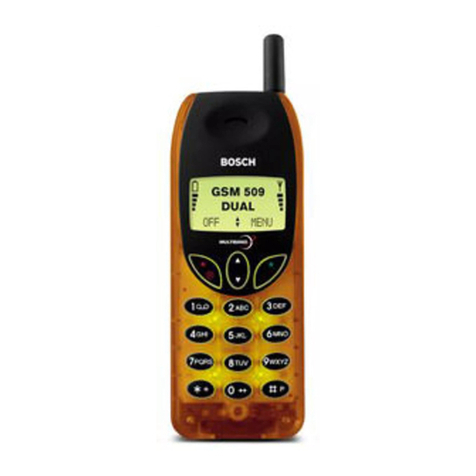
Bosch
Bosch GMS 509 DUAL User manual

Bosch
Bosch GSM 1900 User manual
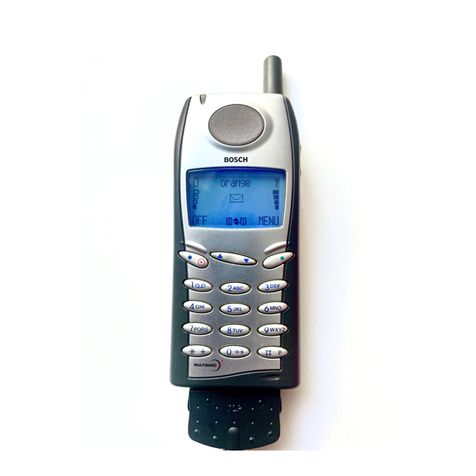
Bosch
Bosch GSM 909 DUAL S User manual
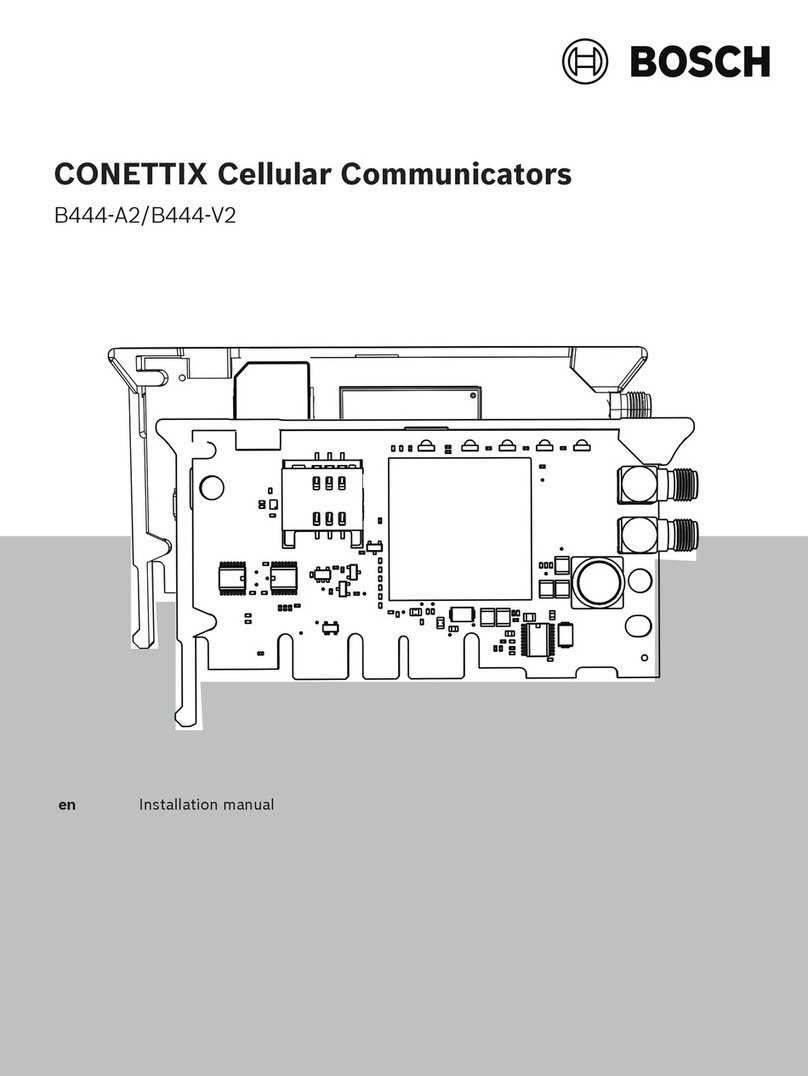
Bosch
Bosch CONETTIX B444-A2 User manual

Bosch
Bosch GSM 509 User manual

Bosch
Bosch Conettix ITS-300GSM User manual
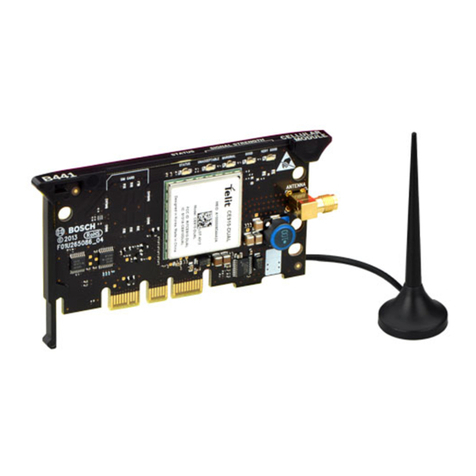
Bosch
Bosch B441 User manual
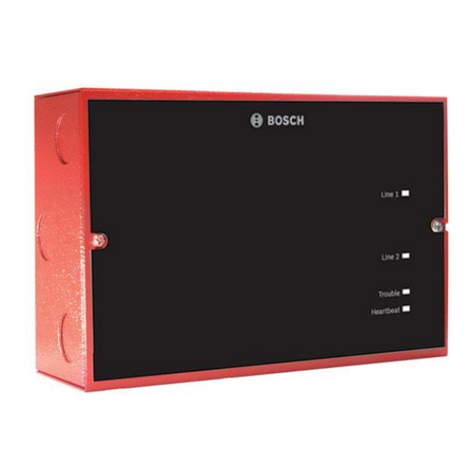
Bosch
Bosch D9068 Quick start guide
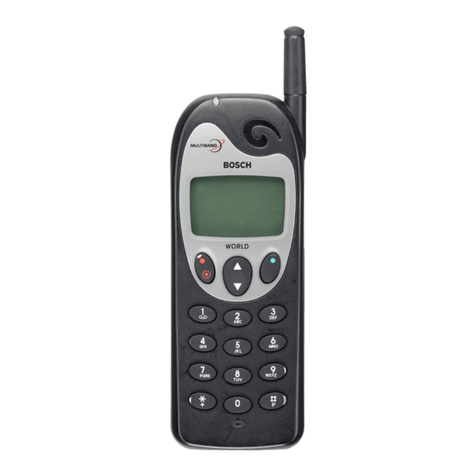
Bosch
Bosch WORLD 718 User manual
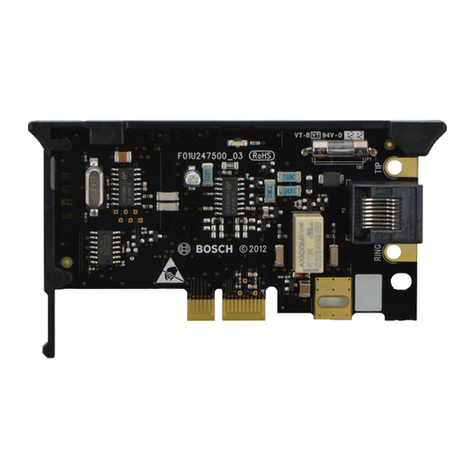
Bosch
Bosch B430 User manual
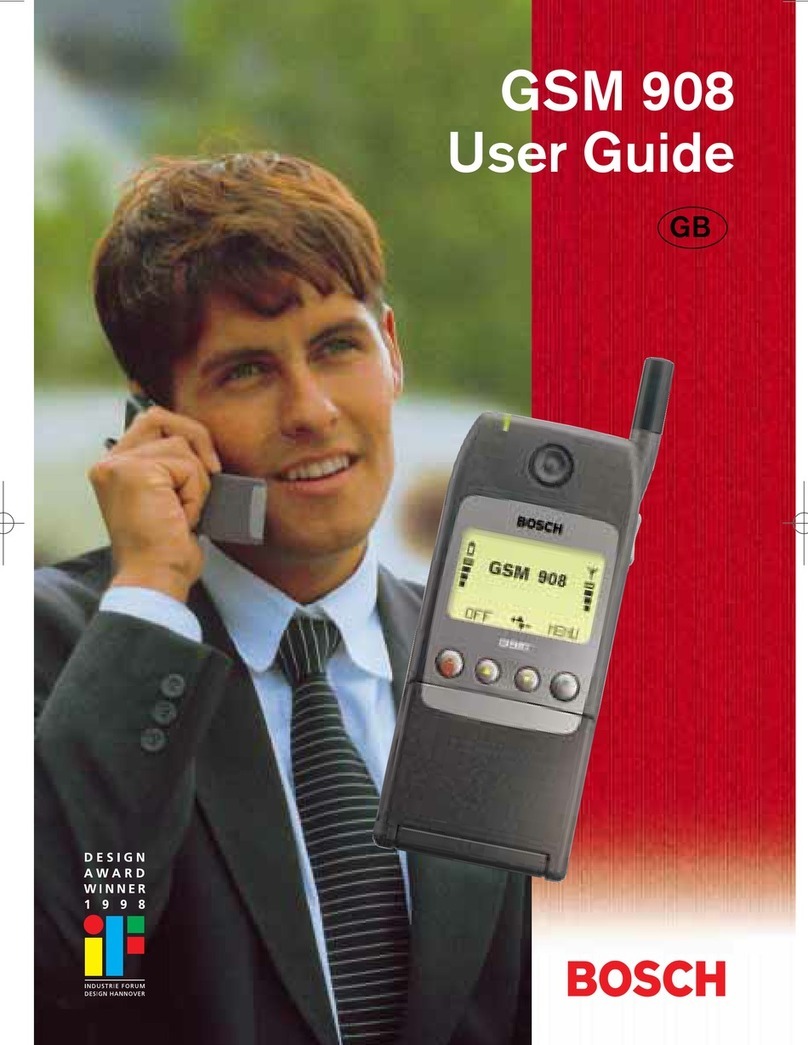
Bosch
Bosch GSM 908 User manual
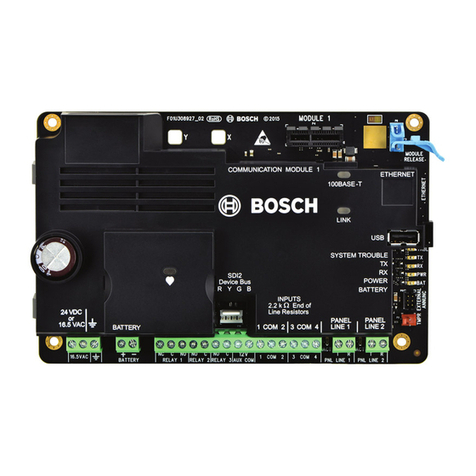
Bosch
Bosch B465 User manual

Bosch
Bosch MM588 User manual
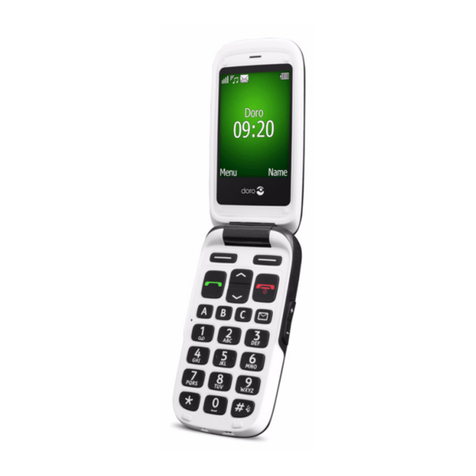
Bosch
Bosch Doro Secure 680 User manual

Bosch
Bosch B465 User manual
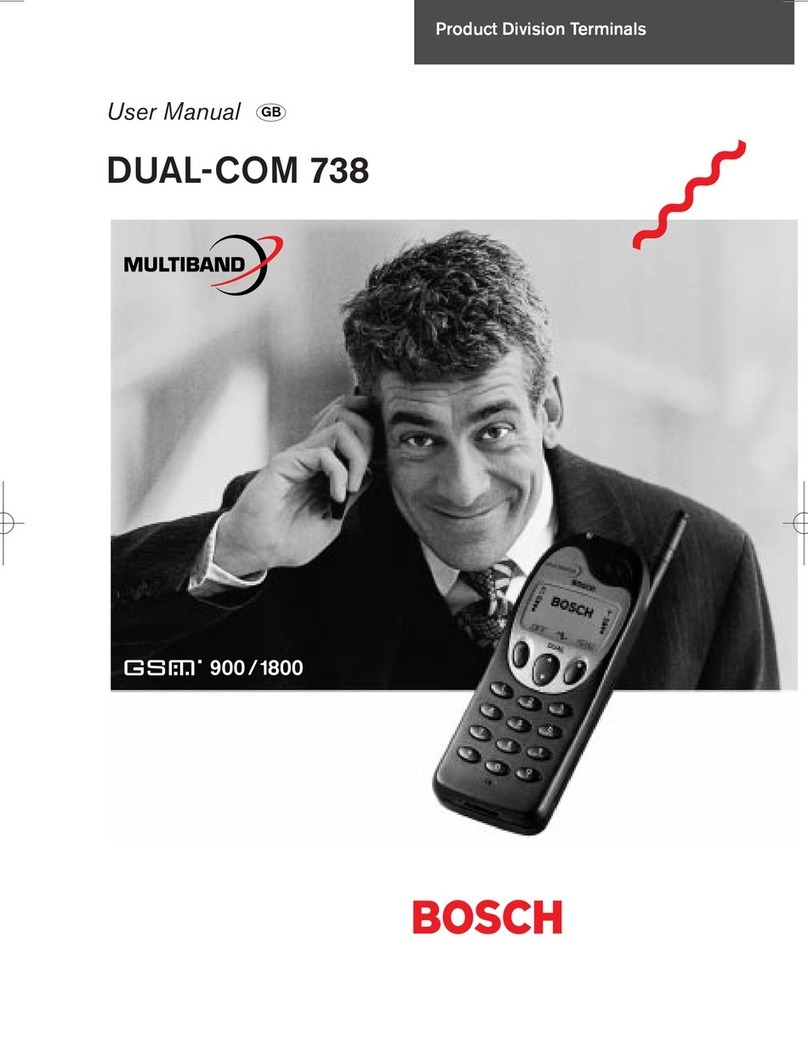
Bosch
Bosch QSM 1800 User manual

Bosch
Bosch B440 User manual
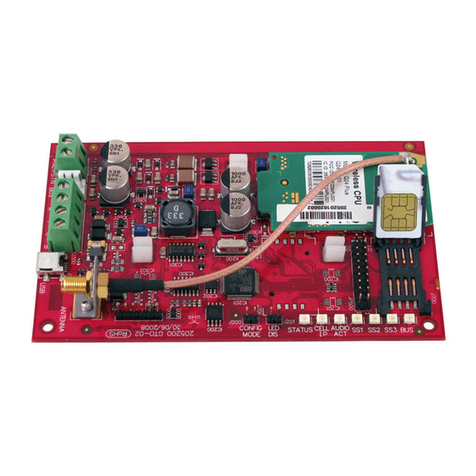
Bosch
Bosch ITS-DX4020-G User manual
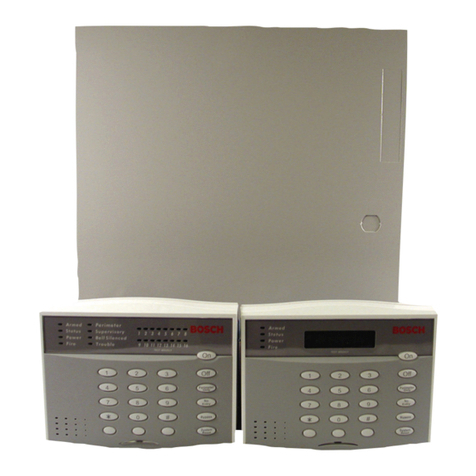
Bosch
Bosch DS7240-UK User manual
